An example search has returned 100 entries
elgai
v.n. expand as a leaf
bookmarkelumai
n. cloth (related to nelmai)
bookmarkemilmat
adj. green, blue
bookmarkEt elwa nieg
phr. the reeds blossom.
bookmarketi laulau
adv. soon
bookmarkgirigiri
n. coconut basket
bookmarkhan
v.n. to go
bookmarkigcahi
n. landward
bookmarkijumgan nijomcan
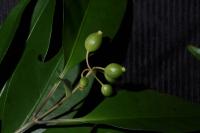
n. small tree, 1-2 m tall (collection: Gregory M. Plunkett #4020)
Example: 1. The name of this plant translates as bad tooth, and relates to its use as a plant used to poison others. If one wants to commit an evil act against another, he or she will rub the leaves together and squeeze them over the targets food. It will make their teeth rotten and fall off quickly. More information witheld.
bookmarkincei franse
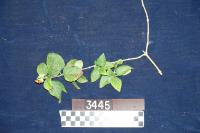
inhamesei
n. the name of a native plant
bookmarkinhenid
n. kind of sugarcane
bookmarkinmac
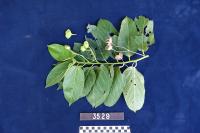
inmohoc onubidou
inrigen natmas
n. kind of banana
bookmarkintejed
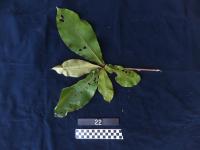
n. tree. Growing in village garden. (collection: Ashley A McGuigan #22)
Example: 1. Timber for houses, hard wood. 2. Fruits have a highly desirable nut that is edible when fresh after cracking the fruit. 3. Medicine – 5 young tips, boiled in 3 cups of water, and steam eyes when have conjunctivitis. 1x. 3. Calendar plant – When the leaves turn red and are ready to fall off from the tree – the lobsters are ready to be harvested – best time to harvest lobsters. Firm tasty meat. This was a traditional population management so that lobsters were not harvested year around but only during this season, Oct–Nov, for a month or 1.5 months.
bookmarkintiklan cai
n. tops of branches
bookmarkintisianibul
n. rose
bookmarkintopasyejitohou
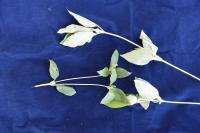
n. herb to 50 cm tall, flowers yellow. (collection: Michael J. Balick #4947)
Example: To treat toothache, collect the uppermost young leaves, rub them in your hand, put mass of crushed leaves into the area of toothache to lessen the pain. Do this as needed until the pain goes away. Keep it in your mouth for 10 minutes then spit out, then add a new one, keep going as needed.
bookmarkintop̃asiej
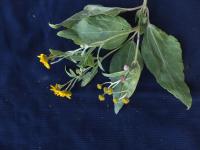
n. herb. Grows on the coast. (collection: Ashley A McGuigan #18)
Example: 1. For painful urination - The first way to prepare this it to take four big leaves and pound them with some water to get out the juices and squeeze this into a cup and drink. This can also be given to babies and children. The second way is to take two small leaf tops and two that are slightly larger tops. Chew these leaves and try to swallow all of it, if you can’t swallow the leaves then spit out the fibers and only drink the juice. 2. Calendar plant – when it flowers, turtle has fat in them, hang turtle to dry, fat melts, and can collect and eat it. Past practice – not eaten now. 3. Young parts of leaves can be cooked as a cabbage with coconut milk. 4. Wrap fish, especially those from the sea, with this leaf – first take lap lap leaf, then layer with this leaf, then wrap fish tie with pandanus for cooking on charcoals. Also with reef fish can wrap and cook directly on charcoal. Then eat leaf with the fish. 5. Medicine – top unrolled leaf tips, – new baby put this in his mouth and then take it out again – believe that it will make the baby talkative – 1x only when 1-2 days old. Put tip on tongue – shut mouth for a few seconds then pull it out. 6. Tips of leaves for diarrhea – remove old leaves, take 1 tip for baby, adults 2-3 tips, chew it, swallow juice and spit out fiber. 1x day, 3 days.
bookmarkinyacelcou
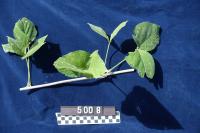
n. vine running many meters long over clay soil and grassy area on hillside where the triangular wooden signs are that used to be a landmark for ships coming to the island. Sterile. (collection: Michael J. Balick #5008)
Example: This plant is the focus of an important legend on Aneityum. When the missionary John Geddie and colleaguse first arrived on the island in July of 1848, the Chiefs welcomed them but some of the people did not like the idea. So these people sent a basket containing a peeled coconut and a fish (nopom) to the Chief in Umej to ask him to support the idea of getting rid of the missionary that the Chief of Analcahuat had welcomed. If the Chief of Umej were to eat the fish and coconut meat, it would mean that he agreed with the opposition. The Chief refused to eat the food in the basket and he told the people a parable involving this plant. A person cannot find the tip of the stem or the end of the root in the ground. So if they were to eliminate the missionary, his activity would continue because of God’s power. As it is with this plant, it will continue to grow and flourish if you cut it or try to dig up the root. So he sent a message about this plant to the people in Analcahuat who objected to the presence of the missionary stating this parable. Those people in Analcauhat held a secret meeting and they chose a powerful and strong person to kill the missionary. During the night the person went to the missionary’s house while he was in the toilet. Returning to the house, the missionary found the person in his doorway, and that person lifted his club to strike the missionary. But at that point the attacker’s hands suddenly had no power and the club fell from his hands, and he fell over. The missionary told him to get up, and not come back. After that experience, the people of Umej realized that God’s power was great and they could not go against it. The Chief took the peeled coconut that was sent him and covered it with the skin of another coconut and planted it instead of eating it. This coconut grew and the missionary’s work continued to grow on the island. So this vine played an important role in communicating the power of God to the people of Aneityum.
bookmarkisji ariko
v. to gather beans
bookmarkmaranapa
n. kind of banana
bookmarkmure
adj. ripe, as arrowroot; also "murre"
bookmarknaerek
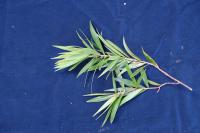
n. shrub, 2 m tall (collection: Gregory M. Plunkett #3492)
Example: 1. Used for firewood. Whole plant used to make a broom for sweeping by tying the small branches together. The very topmost leaves are used when planting kava, as a “superstition” you hold a lead between your big and second toes when tamping the earth down for a kava plant, to give power to earth so kava grows well. 2. This plant is used to make a local broom. Collect a number of branches, let them dry in the sun--the leaves will fall off--then tie the branches together with a piece of Pandanus leaf or any other vine that is handy.
bookmarknahleuco yag
n. kind of taro
bookmarknamesei
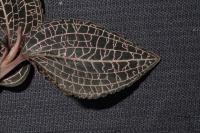
namlau
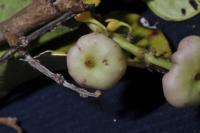
namñiañia
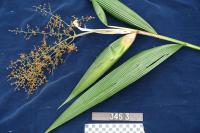
naparap
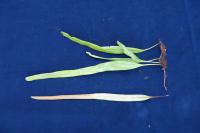
n. epiphytic fern on main tree trunk, growing in dry forest. (collection: Gregory M. Plunkett #3504)
Example: This is a medicine to treat fresh cuts. Take the leaf of this species, macerate it and add 1 tablespoon of water and wrap in a Macaranga leaf, and then heat it on a fire. After heating, puncture the side of the Macaranga leaf and drop the hot juice on the fresh cut. This is said to be good before going to see the Dispensary or if you do not have access to a health care professional.
bookmarknapau
n. kind of tree
bookmarknapleañ

napun nitai caig
n. the skin or rind of food
bookmarknawod
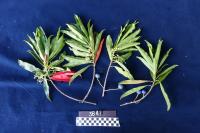
n. tree, 12 m tall (collection: Gregory M. Plunkett #3641)
Example: 1. The wood of this tree is used to make temporary houses, for example, when making a garden by the river. 2. The wood can be sawn into timber. 3. People collect red leaf and put under tongue when want to talk about conflicted issues such as a dispute to make their argument stronger.
bookmarknecemas
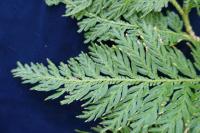
n. fern to 30 cm, cones green (collection: Michael J. Balick #4919)
Example: Use this plant to send a message to someone that another person has died. Take 1 dried leaf, to pass message to another village/tribe or people. Hold it in your hand and walk past a person, then they know that someone has died.
bookmarknegejwaj
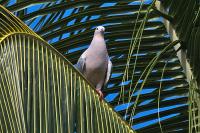
nejeg
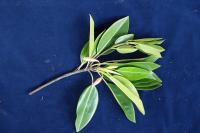
n. tree, growing in forest at edge of wide tidal stream (collection: Gregory M. Plunkett #3535)
Example: 1. The wood is strong and good to make house posts. People use these for this purpose on the coast as salt water does not bother this wood. 2. People eat fruit, split fruit in half, carefully scrape the inner part into a pot of water, keep over night – next day rinse, fry or cook with coconut milk and can add tinned tuna for example, very hard work.
bookmarknejev

n. Skipjack tuna
Example: Photo by Krw130lm / Fishes of Australia, License: CC BY-A-SA 3.0 via Fishes of Australia
bookmarknekro
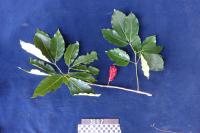
nelm̃ae
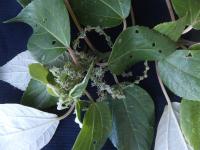
n. small tree. Found in the village, but not cultivated. (collection: Ashley A McGuigan #17)
Example: 1. Ancestors used this plant to make fish line – cut young branches, remove outer bark and tie together, put in salt water or fresh water for a week, it is now strong, dry in sun, take fibers and twist them together to make a very long fishing line. 2. Leaves are used to feed pigs. 3. Take inner bark, scrape it and put on boils. Attach with any leaf and it takes out the boil. 4. Trunk for temporary bush house.
bookmarknepiloan
n. tender shoots
bookmarknepjenepjen
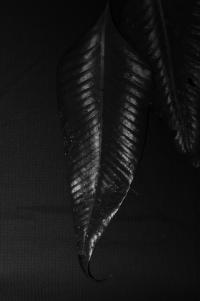
n. epiphytic vine climbing on trees, growing in dense rainforest. (collection: Gregory M. Plunkett #4091)
Example: 1. When a child is between 1 mos. and 1 yr. if the father persists too soon in resuming sexual relations with the mother, the child can become sick. In preparation for the sickness, green leaves are collected. When the sickness occurs, the leaves (now dry) are burned and the baby is washed with the charcoal. 2. After visitors leaves one’s house, one must not hurry to return to their gardens. One waits a few days, then swims with the rachis of this fern tied about their waist. If this practice is not followed, it is believed that the plants in one’s gardens will grow weak.
bookmarknetemu
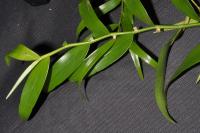
neuled
n. kind of sugarcane
bookmarkneusjai
n. a fern tree
bookmarknigehagid
n. kind of banana
bookmarknijkowai
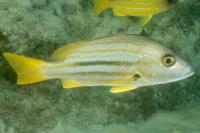
n. Spanish flag, stripey
Example: Photo by Ian Shaw / iNaturalist.org, License: CC BY-NC 3.0 via Fishes of Australia
bookmarknipʧinite
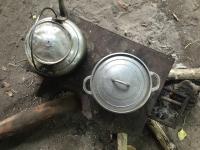
nisbähäin
n. Dracaena angustifolia
Example: Leaf: cold maceration, emetic, taken internally against ciguatera poison
bookmarknobom

n. Bigeye scad
Example: Photo by J.E. Randall / Fishbase, License: CC BY-A-NC 3.0 via Fishes of Australia
bookmarknofar
n. a native pudding made with yam and coconut
bookmarknohos futuna
n. the Futuna banana
bookmarknohwai itai
n. berry
bookmarknohwai itai
n. corn
bookmarknomojced

n. terrestrial fern growing in rain forest on the mountain slope. Leaves dimorphic. (collection: Gregory M. Plunkett #3285)
bookmarknopugei

nuarin abras
n. cliff
bookmarknuei

n. vine climbing up a dead tree, growing in dense rainforest. Fruits green. (collection: Gregory M. Plunkett #4056)
Example: 1. The stems are used as a traditional rope to fasten house posts. First a length of stem is coiled in a figure-eight pattern. It is then heated to render it pliable. Once heated, for several minutes, it is immediately used to fasten the posts. When cool, it is set and inflexible. Such a fastener can last 20 years.
bookmarknugnyiobod
n. kind of plant, grass, or fern
bookmarknumalpau
n. wind-related term; no definition provided
bookmarknumuyehec

nuputreiki
n. kind of tree
bookmarknuripapa
n. wind-related term; no definition provided
bookmarkupjira
n. a kind of tree
bookmarkwud yi encreucaig
v.a. beat so as to shake a tree
bookmarkäminäkäi
n. Marattia smithii
Example: Frond: bathe in infusion, neurodermatitis and infantile eczema
bookmark











